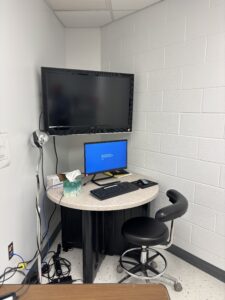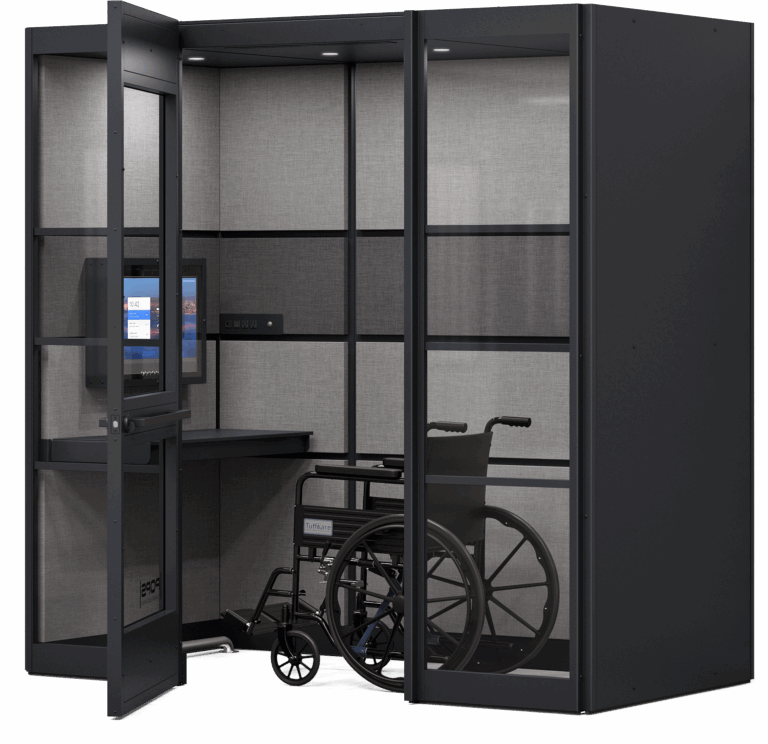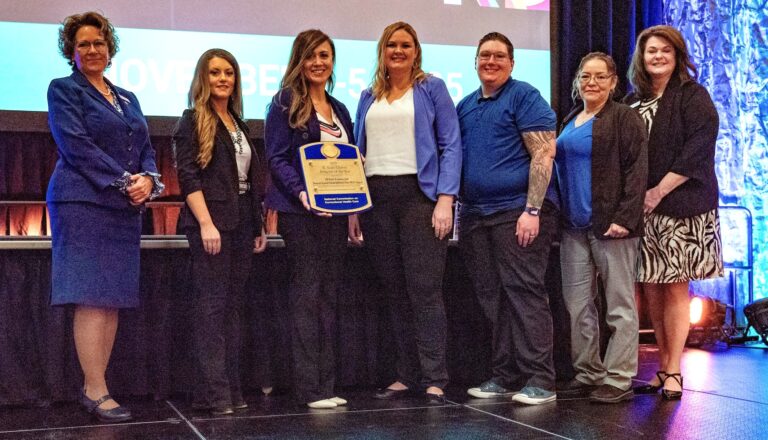Broomfield Detention Center is Shaping the Future of Correctional Technology

By Kat Balster
Technology innovation in carceral environments presents both a broad-sweeping challenge and a fertile ground for growth. Unlike other public sectors, corrections often sees a much slower adoption of new technology, largely due to budget constraints, aging infrastructure and legislative hurdles. However, the unique needs of correctional facilities—spanning security, rehabilitation and operational efficiency—have driven the rise of creative solutions that aim to enhance safety, reduce recidivism and streamline facility management.
For a firsthand look at real-world applications of technology in correctional settings, Correctional News toured the Broomfield Detention Center (BDC), a municipally run jail located in the northwest area of Denver. Known for its commitment to innovation, BDC serves as a testing ground for new correctional technologies.
Commander Shawn Laughlin, a member of the Correctional News Editorial Advisory Board and the 2024-25 president of the American Jail Association, describes BDC as an “incubator for technology” in the corrections industry.

“For us, embracing technology isn’t just about keeping up—it’s about staying ahead. We want to serve as a model for other facilities, showing how innovative solutions can make correctional operations safer, smarter and more efficient,” said Laughlin.
BDC’s size (averaging 65-70 inmates/day in 2024), flexibility and leadership-driven approach make it an ideal proving ground for emerging correctional technologies. The facility has actively partnered with technology providers to test solutions that could eventually be implemented nationwide, while helping develop policies and best practices for integration and operations.
Innovations in corrections technology can be generally categorized into three main areas: safety and security, rehabilitation and operational efficiency. Innovations such as virtual reality (VR) training and artificial intelligence-driven (AI) education support rehabilitation by preparing inmates for reintegration, while AI-powered surveillance, contraband detection, and drone defense systems enhance security and staff safety. At the same time, automation, telehealth, virtual courts and RFID tracking are streamlining operations, reducing long-term costs and easing staff workload.
Rehabilitation Technology
Recidivism reduction is a key metric upon which corrections agencies hinge the success of their programs and efforts. The National Institute of Justice has provided preliminary evidence that VR can be used to rehabilitate inmates by placing them in simulations of potentially stressful real-world scenarios, such as public transportation, job interviews and other common interactions they will have upon release. Experiencing those environments and building the skills to navigate them through roleplaying in a risk-free environment can improve successful reentry. Oftentimes, this VR application is tied into AI to personalize programs for each participant.

Technology that allows for increased connection with the world, whether by video communication with families or via controlled access to tablets, has also been linked to better inmate outcomes. The more integrated that inmates can remain with their communities and support networks, the lower their likelihood of re-offending and being re-incarcerated.
Securus Technologies has been at the forefront of this connectivity revolution, providing incarcerated people with secure communication solutions, from phone to video and text, that help maintain family ties. The company’s tablet programs, which are deployed in numerous correctional facilities, also provide inmates with controlled access to educational courses, vocational training and telehealth services. The tablets serve a dual purpose: They facilitate personal development while also reducing idleness, a common factor in institutional incidents, making facilities safer and calmer. Moreover, Securus’ video visitation services enable inmates to maintain meaningful relationships with loved ones, which positively impacts mental health and post-release reintegration success.
The newest iteration of the tablet, the EVOTAB, is being tested in a pilot program at BDC. Laughlin sees the technology as a key component in the strategy to better prepare individuals for reentry. The EVOTAB advances the technology offerings by providing LTE connectivity, while they are built to leverage Android Enterprise and managed Google Play, improving access and efficiency in facilities that aren’t built to enable technology. The tablet also has increased durability and security features, such as tamper alarms, GPS tracking, biometric authentication and military-grade durability. Inmates can use the tablet to place phone calls, order items from commissary, review facility handbooks and complete required trainings.
“The ability to implement LTE-enabled tablets in a correctional facility opens new doors for both security and connectivity,” said Jessica Lust, chief product officer at Securus. “[BDC] provides an ideal testing ground where we can evaluate cell quality, security measures and user experience in real time.”
Improving Safety and Security

The existence of contraband in correctional facilities has a direct impact, not only on the safety and security of staff but also on the effectiveness of rehabilitative efforts. As security challenges become more sophisticated, the need for innovative, tech-driven solutions has grown. These advancements include AI-powered monitoring, wearable biometric tracking, contraband-detection systems and real-time inmate communication analysis.
Whether scanning inmate mail to be distributed digitally, reducing the risk of contraband smuggling, or using RF-disabling technology to detect and block illicit cell signals, correctional facilities are turning to AI- and data-driven tools to enhance safety. The growing use of illicit drones to drop contraband into secure facilities has also fueled a surge in counter-drone technologies.
AI is at the forefront of these innovations, offering correctional institutions real-time monitoring, predictive analytics, and automation that significantly enhance operational efficiency and security. However, concerns about AI bias, oversight and decision-making autonomy continue to be discussed.
Enhancing Efficiency
As correctional facilities seek to improve efficiency, reduce costs, Biometric tracking allows officers to monitor high-risk inmates. and streamline processes, the adoption of interoperable technology, virtual court systems and telehealth solutions has gained momentum. These innovations enhance inmate care, minimize unnecessary delays, and optimize facility operations, particularly in an era of staff shortages and increasing healthcare demands.
Colorado Trusted Interoperability Project Models Data Sharing
BDC is a key testing site for Colorado’s Trusted Interoperability Project (CTIP), which enables real-time data sharing between jails. Previously, facilities relied on faxed documents and calls, leading to delays. With MuleSoft’s API-driven integration, correctional officers can instantly access custodial records from multiple jails, improving inmate classification, medical care and security. CTIP also automates reporting, reducing administrative burdens. BDC has further pioneered automated warrant processing, helping identify inmates with outstanding warrants, minimizing redundant arrests and conserving law enforcement resources. demands significantly.
“We are leveraging data in ways never done before in corrections,” said Laughlin.
Advancement of Virtual Court
BDC was one of the first jails in Colorado to implement video court hearings, offering a secure web portal for weekend and remote court proceedings. This enables inmates to attend hearings remotely from the facility, hospital or other locations. “Virtual court has cut our transport miles and staffing demands significantly,” said Laughlin. “Not only does this reduce operational costs, but it also increases safety by minimizing inmate movement outside the facility.”
BDC provided statistics on the total amount of inmate transports, which includes writs, court proceedings and hospital appointments. Unit trips fell from 2,855 in 2019 to 642 in 2024, while the total number of video court appointments increased from 1,536 to 2,329. The ability for officers to update the Jail Management System (JMS) in real time further streamlines the process.
Telehealth and Inmate Medical Efficiency
BDC is advancing correctional healthcare through telehealth and telepsychiatry, improving access to care while reducing operational strain. Virtual medical consultations, mental health screenings and e-signed waivers allow for faster and more efficient care delivery. BDC is also the first jail to integrate with the regional Health Information Exchange (HIE), granting staff immediate access to detainees’ full medical records upon intake. This reduces duplicate assessments and ensures continuity of care.
“Access to comprehensive medical history is a game-changer in correctional healthcare,” said David Walts, commander at BDC. “When someone enters our facility, we don’t have to start from scratch. We can immediately see existing diagnoses, prescriptions and treatment plans, allowing us to provide appropriate care from day one.”
Future Trends in Technology
The corrections industry is experiencing a technology renaissance. With new solutions that redefine security, rehabilitation and efficiency continually appearing, facilities must navigate regulatory, ethical and budgetary constraints to fully harness the benefits of emerging technologies. Facilities like BDC demonstrate the potential of early technology adoption, but broader systemic hurdles—including aging infrastructure and varying state regulations— slow widespread implementation. Remaining focused on the desired outcome, rather than the shine of new technology, will help agencies to identify the best solutions for their communities.
This article was originally published in the March/April edition of Correctional News.





